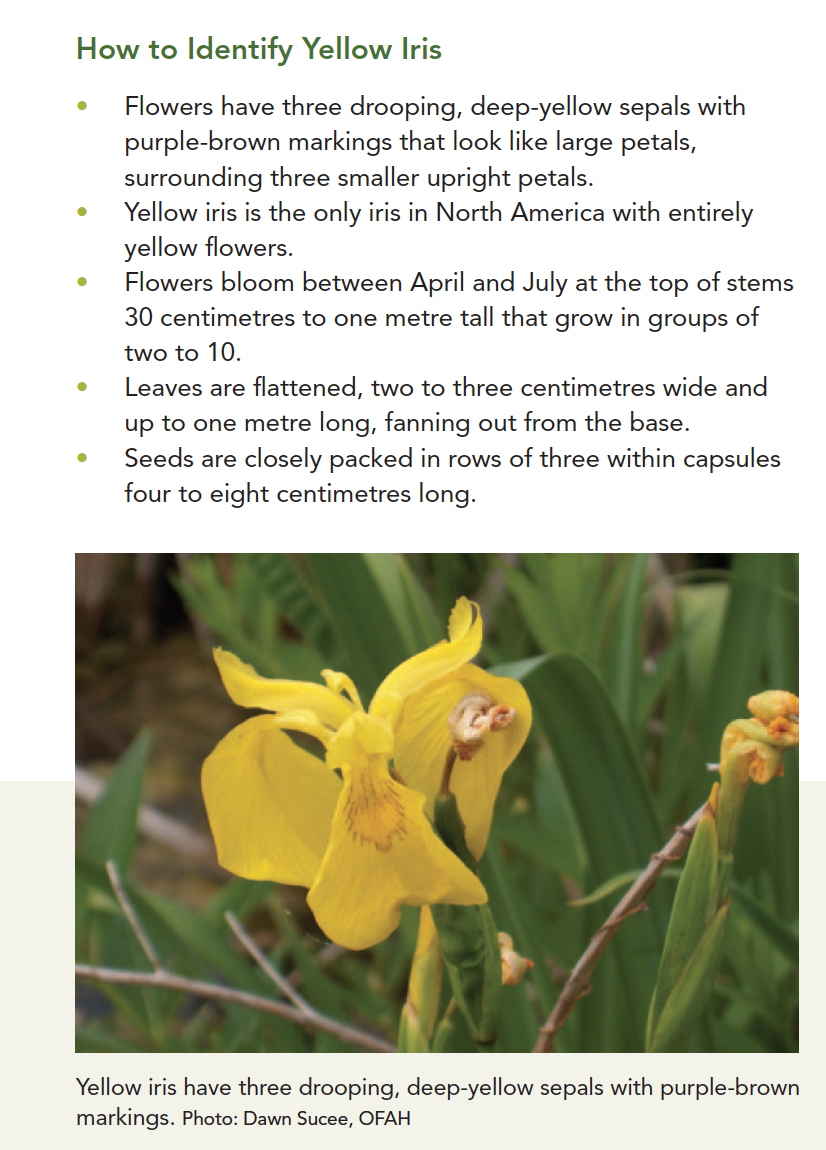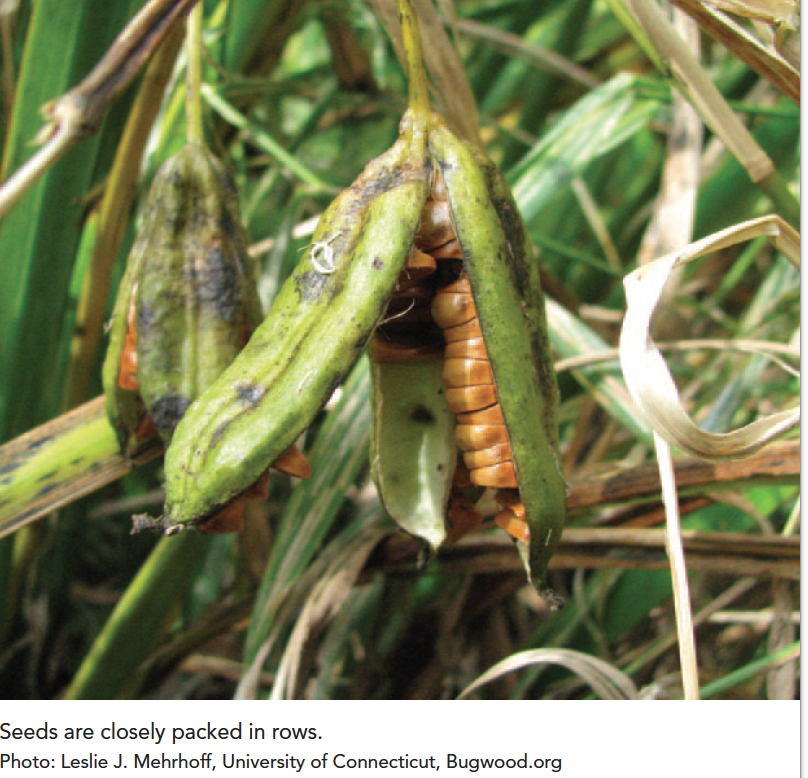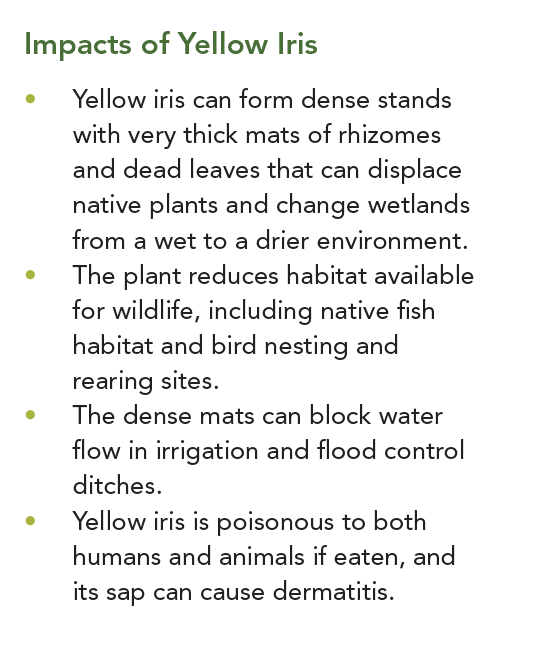Control, and Management
Small clumps can be dug out, though this is only effective if the rhizomes are entirely removed. Mowed plants will regenerate from the rhizomes, so plants must be cut multiple times to exhaust their energy reserves. The sap may cause skin irritation, so gloves should be worn when handling cut or otherwise damaged stems. Glyphosate herbicides approved for aquatic use can be effective, particularly if applied to recently cut foliage and stems. No biological control agents have been released to control yellow flag. [Note: Always check state/provincial and local regulations for the most up-to-date information regarding permits for control methods. Follow all label instructions.]
Background
Commonly grown and transplanted for its showy yellow flowers, yellow flag iris (yellow flag) has invaded wetlands and other aquatic and semi-aquatic habitats. Yellow flag can be found at the edges of streams and ponds, in open and forested flood plains, along shorelines, and in freshwater and brackish marshes.
Yellow flag iris, Iris pseudacorus. (Photo: J.S. Peterson. USDA NRCS National Plant Data Center (NPDC), on PLANTS Database)
Origin and Expansion
Yellow flag is native to temperate regions of Europe, Asia, and northern Africa. It was imported to North America as an ornamental plant as early as the late-1700s. The plant has since been deliberately propagated as a horticultural plant and for erosion control and in sewage treatment ponds. It is now present in all but four states.

North American distribution of Yellow Flag Iris (Source: EDDMapS. 2015. Early Detection & Distribution Mapping System. The University of Georgia – Center for Invasive Species and Ecosystem Health, http://www.eddmaps.org/; accessed September 29, 2015).

New York distribution of Yellow flag Iris. Yellow squares are approximated locations; red dots are accurate locations. (Map: imapinvasives.org/nyimi/ accessed Sept. 2015)
Yellow flag is a perennial. Shoot emergence and most seedling germination occur in spring, though in mild winters shoots may survive and remain green throughout the year. Flowering begins by late-May and continues into early-July. Plants generally do not flower until the third year of growth. Flowers are pollinated by bees and a few species of long-tongued flies. Seed production occurs from August through October; each plant can produce several hundred seeds. Seeds are mainly dispersed by currents, containing an air pocket to help keep them afloat, and are capable of remaining afloat for more than a year. Seedlings germinate and establish best in moist but not waterlogged soil. Yellow flag expands through rhizome growth. The thick rhizomes can persist for over ten years in the soil and can survive for more than three months if dried. The rhizomes of old plants older than ten years often break into fragments, which may then be dispersed by water.
The sword-like leaves are flat, erect and linear with a raised midrib. The dark to blue-green blades are 25-90 cm long and have sharply pointed tips. The flowering stems are usually similar in size to the leaves (50-100 cm in length). Flowers are pale to bright yellow or cream colored and 7-9 cm wide. The large (4-8 cm) seed pod is 3-sided and angular and turns from glossy green to brown as it ripens. Each pod contains dozens of seeds densely arranged in 3 rows. Roots are 10-30 cm in length, and the fleshy rhizomes are 1-4 cm in diameter.
Close-up of Yellow Flag Iris flower (Photo: Nancy Loewenstein, Auburn University, Bugwood.org). Yellow Flag Iris seeds (Photo: Leslie J. Mehrhoff, University of Connecticut, Bugwood.org)
Yellow flag expands quickly via rhizomes, and can form dense monotypic stands that can replace and crowd out valuable aquatic plants like cattails and other, native, irises. The root system forms a dense mat which compacts soil and inhibits seed germination of other plants. Large yellow iris populations may also reduce the habitat available to native fish and waterfowl. Thick growths of yellow flag can clog irrigation systems and streams and, by trapping sediment in the roots, can narrow waterways. All parts of the plant are toxic to livestock and other animals.
Dense growth of Yellow Flag Iris (photo: Todd Pfeiffer, Klamath County Weed Control, Bugwood.org)
Small clumps can be dug out, though this is only effective if the rhizomes are entirely removed. Mowed plants will regenerate from the rhizomes, so plants must be cut multiple times to exhaust their energy reserves. The sap may cause skin irritation, so gloves should be worn when handling cut or otherwise damaged stems. Glyphosate herbicides approved for aquatic use can be effective, particularly if applied to recently cut foliage and stems. No biological control agents have been released to control yellow flag. [Note: Always check state/provincial and local regulations for the most up-to-date information regarding permits for control methods. Follow all label instructions.]
Resources
Iris pseudacorus, Yellow flag iris, Invasive Plants Atlas of New England plant profile: https://www.eddmaps.org/ipane/ipanespecies/herbs/Iris_pseudacorus.htm
Iris pseudacorus, USDA Forest Service FEIS Plant Species Review: http://www.fs.fed.us/database/feis/plants/forb/iripse/all.html [Note: this review includes almost 100 scholarly citations]
Educational Materials
Iris pseudacorus – information entry, Wikipedia: https://en.wikipedia.org/wiki/Iris_pseudacorus
Iris pseudacorus, Paleyellow iris. USDA Natural Resources Conservation Service, PLANTS Database: http://plants.usda.gov/core/profile?symbol=IRPS
Yellow Iris
Iris pseudacorus
Background
Yellow iris, or yellow flag iris, is a perennial aquatic plant native to Europe, western Asia and North Africa. It was first introduced to North America the 1800s as an ornamental plant for ponds and water gardens. The plant has since spread to many waterways, including those in parts of southern Ontario. In addition to its use in gardens, it has been planted in wastewater ponds because it is known to absorb heavy metals.
Yellow iris can grow in both treed and open wetlands, along river and lake edges, and on floodplains. The plant spreads by seeds and by underground stems known as rhizomes that send out new shoots above the ground and roots below. Stands of yellow iris develop thick mats of rhizomes that can connect several hundred plants. Fragments of rhizomes that break off can also form new plants.
Range
The first recorded Canadian sighting of yellow iris was in Newfoundland in 1911. It was found in Ontario in 1940. Today it grows in most Canadian provinces, including parts of southern Ontario, Quebec, Nova Scotia, Newfoundland, New Brunswick, the east coast of Prince Edward Island and the west coast of British Columbia. It is also found in many American states, and in temperate areas worldwide. Several American states ban it or list it as a noxious weed.
Impacts of Yellow Iris
- Yellow iris can form dense stands with very thick mats of rhizomes and dead leaves that can displace native plants and change wetlands from a wet to a drier environment.
- The plant reduces habitat available for wildlife, including native fish habitat and bird nesting and rearing sites.
- The dense mats can block water flow in irrigation and flood control ditches.
- Yellow iris is poisonous to both humans and animals if eaten, and its sap can cause dermatitis.
How to Identify Yellow Iris
- Flowers have three drooping, deep-yellow sepals with purple-brown markings that look like large petals, surrounding three smaller upright petals.
- Yellow iris is the only iris in North America with entirely yellow flowers.
- Flowers bloom between April and July at the top of stems 30 centimetres to one metre tall that grow in groups of two to 10.
- Leaves are flattened, two to three centimetres wide and up to one metre long, fanning out from the base.
- Seeds are closely packed in rows within capsules four to eight centimetres long.
When not flowering, yellow iris looks similar to the native blue flag iris (Iris versicolor). Blue flag iris is usually smaller, with leaves 10 to 80 centimetres long, stems 20 to 60 centimetres long, and purple-to-blue flowers. Yellow iris leaves may also be confused with other wetland plants, such as cattails (Typha spp.) and sweet flags (Acoraceae spp.).
What You Can Do
- Learn how to identify yellow iris and other invasive plants, and avoid planting invasive plants in your garden.
- Buy native or non-invasive plants from reputable garden suppliers. See Grow Me Instead: Beautiful Non-Invasive Plants for Your Garden. Go to ontario.ca/invasivespecies, click on Here’s a list of things you can do to help fight invasive species, and click on the title
- Dispose of invasive plants in the garbage. Do not put them in the compost or discard them in natural areas. Discarded flowers may produce seeds, and seeds may sprout.
- If you find yellow iris or other invasive species in the wild, please contact the toll-free Invading Species Hotline at 1-800-563-7711, or report a sighting online.
Other Resources
- Ontario Ministry of Natural Resources and Forestry
- Ontario Invasive Plant Council
- Invasive Species Centre
OFAH/OMNR Invading Species Awareness Program. (2012). Yellow Iris. Retrieved from: http://www.invadingspecies.com. This factsheet may be reproduced for non-commercial purposes.


 This information comes from “Ontario Invading Species Awareness Program.
This information comes from “Ontario Invading Species Awareness Program.




